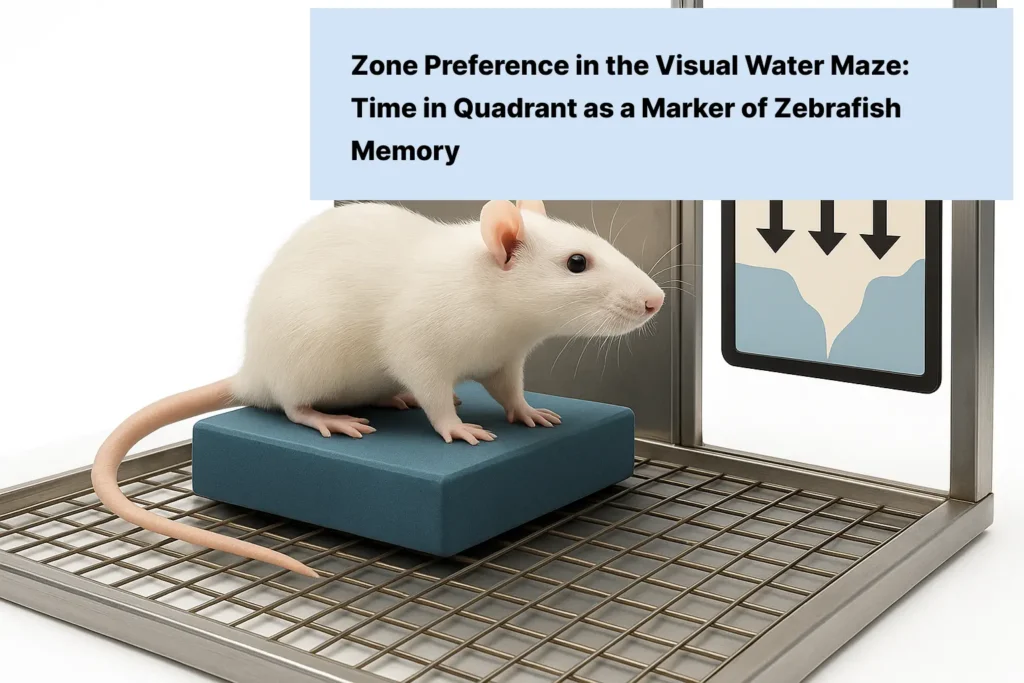

In cognitive neuroscience, one of the most elegant answers to this question lies in zone preference—a spatially driven behavioral readout that reveals whether an organism has formed and retained a memory of a significant location. In zebrafish Visual Water Maze (VWM) studies, this is quantified as “time in quadrant”: the proportion of time the animal spends in the maze’s target quadrant during probe trials.
This simple yet powerful metric turns the fish’s swim pattern into a nonverbal declaration of memory. If the platform is removed, and the zebrafish still preferentially explores the quadrant where the escape platform used to be, it suggests spatial recall and memory consolidation. In this context, zone preference is not just behavioral—it is cognitive evidence.
Zone preference, also known as time in quadrant, is a spatial memory metric that measures the proportion of time a zebrafish spends in a specific region—typically the target quadrant—of the maze arena. In Visual Water Maze trials, the arena is conceptually divided into four equal quadrants. Each quadrant represents 25% of the total area, and the “target quadrant” is defined as the location where the escape platform was consistently placed during the training phase.
During probe trials, the platform is removed entirely. The fish is then introduced into the maze, and its movement is recorded and analyzed. If the fish spends significantly more time in the target quadrant—even though the platform is no longer there—this behavior suggests memory recall of the platform’s spatial location.
This metric is not about escape or performance under pressure, but about preference and spatial bias—making it a powerful measure of retention and long-term memory.
The beauty of the zone preference measure lies in its non-reinforced nature. Probe trials are designed to test retention without any external reward. The absence of the escape platform forces the fish to rely solely on its internal spatial representation—its “cognitive map”—to guide its exploration.
In this context:
Thus, zone preference provides a cleaner and more specific test of spatial memory than reinforced metrics like escape latency.
The behavior underlying zone preference is intentional and often subtle. Zebrafish exhibiting strong spatial recall will:
This behavior is often accompanied by lower velocity, indicating focused searching rather than anxious darting or escape attempts. As such, time in quadrant provides a qualitative and quantitative snapshot of memory expression.
The decision to divide the arena into four quadrants is both practical and analytical:
By establishing this uniform spatial framework, scientists can quantify memory performance against a known probabilistic baseline and determine the statistical likelihood of observed preferences being memory-driven.
Modern behavioral tracking software allows researchers to:
Zone preference—measured as time spent in the target quadrant during a probe trial—offers a window into the zebrafish’s spatial memory system. It captures the essence of retention, revealing whether a fish remembers where the platform was, even when it’s no longer there to guide behavior.
Unlike metrics rooted in reinforcement, time in quadrant reflects uncompelled choice, guided by memory rather than motivation. This makes it one of the most pure measures of spatial recall available in zebrafish behavioral research.
Time in quadrant serves as a direct proxy for memory recall. While metrics like escape latency or path length assess learning during training, zone preference reveals what was retained. It is one of the few metrics that isolates memory from performance, especially when the platform is removed and reinforcement is no longer present.
Let’s break down why this matters.
The fundamental premise of a memory probe trial is that if the subject has retained the spatial association, it will search where the platform used to be—despite its absence.
A zebrafish that consistently spends more than 25% of the trial in the target quadrant (assuming equal-size quadrants) is likely relying on a cognitive map, not random search. This preference becomes the behavioral fingerprint of long-term memory.
Unlike latency or path metrics, zone preference is inherently spatial and less dependent on speed or motor function. A slow or physically impaired fish can still show strong memory by focusing its time in the correct region. This makes it a robust and conservative indicator of recall.
Time in quadrant can also illuminate individual differences in learning strategy:
This stratification is useful when testing the effects of genetic mutations, pharmacological treatments, or environmental stressors on learning style.
Measuring zone preference, or time spent in the target quadrant, requires more than simply observing where a zebrafish swims. To draw valid conclusions about spatial memory, researchers must implement standardized trial design, precise tracking tools, and clear analytical criteria. Conduct Vision’s Visual Water Maze system offers a reliable, zebrafish-optimized platform that supports these needs through custom zone mapping, high-resolution tracking, and quadrant analysis features.
This section outlines key methodological considerations to ensure that zone preference is measured accurately, reproducibly, and meaningfully in your experiments.
Conduct Vision’s Visual Water Maze software allows for precise virtual segmentation of the arena into equal zones. To measure zone preference:
These zone definitions are saved in the software’s experimental layout file, ensuring consistency across trials and subjects.
In a probe trial, the platform is removed, and the zebrafish is placed in the maze without the possibility of escape. The goal is to assess whether the fish remembers where the platform used to be.
Key design elements:
During this trial, the fish receives no reinforcement, making time in the target quadrant a pure expression of spatial memory rather than goal-seeking behavior.
Conduct Vision’s integrated tracking software allows for automated, high-frame-rate monitoring of the zebrafish’s position throughout the trial. Key features include:
You can configure the system to:
Output metrics include:
These quantitative outputs are exportable in CSV or visual formats for statistical analysis and publication.
Zone preference should reflect cognitive recall, not anxiety-driven behavior or motor confounds. To avoid misinterpretation:
Conduct Vision’s tracking system supports multi-parameter behavioral tagging, allowing researchers to cross-reference quadrant time with movement patterns and speed.
Once time in quadrant is measured, researchers must determine whether the observed preference is meaningful. In a four-quadrant system:
To validate this:
Probe trial performance should also be compared to control groups (e.g., untrained or sham-trained fish) to rule out innate side biases or spontaneous zone preferences.
When comparing across experimental groups, such as:
…it is essential to:
Conduct Vision’s built-in tagging and batch analysis features simplify these comparative workflows, allowing you to analyze group performance at scale with high precision.
In zebrafish behavioral neuroscience, zone preference is a window into spatial cognition—a measure of whether an animal recalls the location of a previously reinforced zone after the reinforcement has been removed. With the right tools and methodology, it becomes one of the most reliable and interpretable indicators of memory performance.
Conduct Vision’s Visual Water Maze offers researchers a flexible, intuitive, and high-resolution platform for capturing and analyzing this behavior. By integrating zone preference metrics with heatmaps, swim speed, and trajectory patterns, researchers can construct a multi-dimensional profile of memory-guided search behavior.
With careful trial design and standardized analysis, zone preference becomes more than a behavioral tendency—it becomes a quantifiable signature of learning and memory.
Zone preference behavior is underpinned by neural circuits associated with spatial learning, memory consolidation, and cue integration.
Zone preference is highly informative in experimental models of:
In behavioral neuroscience, data quality is inseparable from data transparency. This principle is especially true when reporting zone preference, or time spent in the target quadrant, as a measure of spatial memory retention in the Visual Water Maze. Because this metric is often used to support conclusions about learning, memory, or cognitive impairment, it must be reported with precision, context, and replicability in mind.
Below are key best practices to follow when reporting zone preference results, both in peer-reviewed publications and internal study documentation.
It’s tempting to report only the percentage of time spent in the target quadrant, but this can lead to misinterpretation of behavioral bias or memory specificity.
Best practice:
This approach allows reviewers and readers to evaluate:
Raw data alone can obscure important behavioral patterns. Visualizations help contextualize zone preference data by illustrating how, where, and when zebrafish focused their exploration.
Use Conduct Vision’s software to generate:
Heatmaps provide spatial precision, while trajectories capture movement quality (e.g., direct searching, circling, scattered paths). Including these in figures or supplementary materials strengthens the interpretability and validity of your conclusions.
To determine whether time in the target quadrant reflects true memory, it must be shown to significantly exceed random allocation. In a four-quadrant system, random exploration predicts 25% time in any one zone.
Recommended statistical tests:
Report:
Clearly distinguish between statistical significance and biological relevance. A marginal difference may be statistically significant but behaviorally trivial—or vice versa.
Reproducibility depends on knowing how zones were defined. Quadrant layouts may vary slightly across labs, software, or tank types.
Always report:
If possible, include a schematic of the arena with quadrant boundaries and platform location. Conduct Vision’s software can export these configurations for use in figure legends or methods sections.
Zone preference is only interpretable when the zebrafish is actively exploring. If the fish is immobile, erratic, or displays thigmotaxis, the data may not reflect cognitive processes.
Be transparent about:
Clearly state how many fish or trials were excluded and why. This transparency strengthens the reliability of your findings and promotes good scientific practice.
To validate that quadrant preference reflects learned behavior, always compare:
Control fish typically show no quadrant bias. A trained fish showing significantly greater time in the target quadrant relative to controls provides robust evidence of memory.
Statistical analysis should examine both within-group effects (vs. chance) and between-group differences, especially in studies involving:
For clarity:
These details ensure that results are understandable, comparable, and citable by other researchers in the field.
Zone preference is a cornerstone behavioral metric in the Visual Water Maze. When measured and reported with care, it becomes a precise and interpretable indicator of spatial memory. But like any powerful tool, its validity depends on the rigor with which it is applied and communicated.
By reporting all quadrant data, providing visual context, applying appropriate statistical tests, documenting methodology, and comparing to controls, researchers can ensure that their zone preference findings are not just technically correct, but scientifically compelling.
Clear, reproducible reporting isn’t just good practice—it’s good science.
In the Visual Water Maze, zone preference transforms swim space into memory space. Where the zebrafish chooses to search—especially in the absence of reinforcement—reveals not only what it remembers, but how confidently it recalls.
For researchers, time in quadrant is a behavioral lens—an efficient, interpretable, and statistically sound method for identifying cognitive function and dysfunction. In disease models, it distinguishes pathology from performance; in drug studies, it validates efficacy; in developmental assays, it traces the ontogeny of spatial skills.
In essence, zone preference is where cognition leaves a spatial footprint.
